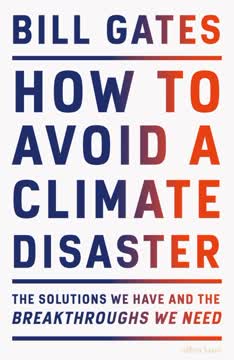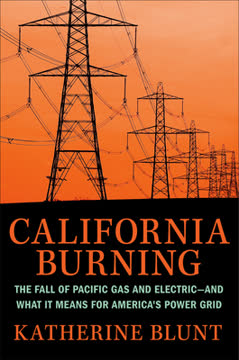Key Takeaways
1. The grid: A complex system of power generation, transmission, and distribution
America runs on electricity. The age of information has remade the ways we communicate, socialize, and even learn things into electricity-dependent processes.
The grid is ubiquitous yet invisible. It is a vast, interconnected system that powers every aspect of modern life. This complex machine consists of power plants, transmission lines, substations, and distribution networks that work together to deliver electricity from generators to consumers. The grid is so ingrained in our daily lives that we rarely notice it until something goes wrong.
The grid faces numerous challenges:
- Aging infrastructure
- Increasing demand
- Integration of renewable energy sources
- Cybersecurity threats
- Climate change impacts
Despite these challenges, the grid remains the backbone of our modern society, enabling everything from smartphones to industrial processes.
2. Historical development: From Edison's first grid to the modern electrical infrastructure
Though it is situated squarely at the center of our modern lives, for most Americans the grid rarely breaches consciousness.
The grid evolved from small, isolated systems to a vast network. Thomas Edison's Pearl Street Station in 1882 marked the beginning of the modern electrical grid. Initially, competing systems and standards created chaos, with multiple overlapping grids in cities.
Key milestones in grid development:
- 1880s: Edison's DC system vs. Tesla/Westinghouse's AC system
- 1890s: Standardization of AC as the dominant system
- Early 1900s: Consolidation of power companies
- 1930s: Rural electrification
- 1960s-present: Increasing complexity and scale of the grid
The grid's history reflects broader societal changes, from urbanization to the rise of consumer culture and the digital revolution.
3. Challenges of renewable energy integration and grid stability
Electricity is not like anything else. It's not a solid, or a liquid, or a gas. It isn't quite like light or heat. It doesn't move like the wind or the tides.
Renewable energy sources pose unique challenges to grid stability. Unlike traditional power plants, wind and solar generation are variable and often unpredictable. This variability can cause sudden fluctuations in power supply, potentially destabilizing the grid.
Challenges of renewable integration:
- Intermittency of wind and solar power
- Need for flexible backup generation
- Transmission infrastructure limitations
- Voltage and frequency regulation
- Energy storage requirements
Grid operators must constantly balance supply and demand, a task made more complex by the increasing share of renewable energy. This balancing act requires new technologies, improved forecasting, and innovative grid management strategies.
4. The impact of deregulation and market forces on electricity production
The Energy Policy Act turned electricity into a commodity—a thing like any other.
Deregulation transformed the electricity industry. The traditional model of vertically integrated utilities gave way to a more competitive market structure. This change aimed to increase efficiency and lower costs but also introduced new complexities and risks.
Effects of deregulation:
- Separation of generation, transmission, and distribution
- Introduction of wholesale electricity markets
- Increased competition in power generation
- Rise of independent power producers
- New financial instruments and energy trading
While deregulation has brought some benefits, it has also led to unintended consequences, such as the California energy crisis of 2000-2001 and increased vulnerability to market manipulation.
5. Climate change and extreme weather events: Straining the aging grid
Electricity consumption on this, the world's largest machine, must at every moment be balanced with electricity production.
Climate change poses existential threats to grid reliability. Extreme weather events, such as hurricanes, heatwaves, and winter storms, are becoming more frequent and severe, putting unprecedented stress on the electrical infrastructure.
Climate-related grid challenges:
- Increased peak demand during heatwaves
- Damage to transmission lines from storms and wildfires
- Flooding of coastal infrastructure
- Reduced efficiency of thermal power plants
- Need for more robust and resilient grid design
The grid must adapt to these changing conditions while simultaneously transitioning to cleaner energy sources to mitigate further climate change.
6. Microgrids and distributed generation: Reshaping the future of electricity
Microgrids can, thus, provide grid resiliency in two quite different ways: at home they can help keep the lights on during severe weather or other "complexity" generated blackouts and further afield they simplify supply chains that are inherently vulnerable to disruption or attack.
Microgrids offer local resilience and flexibility. These small-scale power systems can operate independently or in conjunction with the main grid, providing increased reliability and efficiency. Distributed generation, such as rooftop solar panels, is transforming consumers into "prosumers" who both produce and consume electricity.
Benefits of microgrids and distributed generation:
- Enhanced local resilience during outages
- Integration of renewable energy sources
- Reduced transmission losses
- Potential for improved energy efficiency
- Empowerment of communities and individuals
The rise of microgrids and distributed generation is challenging the traditional centralized grid model and forcing utilities to adapt to a more decentralized future.
7. Smart grids and demand response: Balancing supply and consumption
A virtual power plant is thus primarily an organizational tool that uses information about electricity transmitted by electricity (digital smart meters most especially) to respond to the ebb and flow of power on the grid with a degree of timeliness and nuance that a human simply cannot match.
Smart grid technologies enable real-time optimization. By integrating advanced sensors, communication networks, and data analytics, smart grids allow for more efficient management of electricity supply and demand. Demand response programs incentivize consumers to adjust their usage patterns to balance grid load.
Key features of smart grids:
- Two-way communication between utilities and consumers
- Real-time monitoring and control of grid components
- Automated fault detection and self-healing capabilities
- Integration of electric vehicles and energy storage
- Enhanced cybersecurity measures
Smart grids and demand response programs are essential tools for managing the increasing complexity of modern electrical systems and integrating higher levels of renewable energy.
8. The quest for energy storage: Key to a renewable future
Finding a way to store electricity so that it is there to be used when we need it is at the top of every ideologue's list.
Energy storage is crucial for a renewable-powered grid. The intermittent nature of wind and solar power necessitates effective storage solutions to ensure a stable and reliable electricity supply. While batteries are a prominent focus, other technologies are also being developed and deployed.
Energy storage technologies:
- Lithium-ion batteries
- Pumped hydro storage
- Compressed air energy storage
- Flywheel energy storage
- Thermal energy storage (e.g., molten salt)
- Hydrogen fuel cells
The development of cost-effective, large-scale energy storage is widely seen as the "holy grail" that could enable a fully renewable electricity system.
9. Efficiency and conservation: The power of negawatts
Customers don't want kilowatt-hours; they want services such as hot showers, cold beer, lit rooms.
Energy efficiency is the cheapest and cleanest "source" of power. Reducing energy waste through improved efficiency and conservation measures can significantly decrease the need for new generation capacity. This concept of "negawatts" – energy saved through efficiency – is gaining recognition as a valuable resource.
Strategies for improving energy efficiency:
- Building insulation and weatherization
- LED lighting and smart thermostats
- High-efficiency appliances and HVAC systems
- Industrial process optimization
- Behavioral changes and energy awareness programs
Prioritizing efficiency and conservation can lead to substantial cost savings, reduced emissions, and a more resilient grid.
10. Grid reform: Balancing competing interests for a resilient future
Coming up with a good system for grid-scale storage, with its capacity to unlink generation from consumption, is one way of pushing the grid toward a more open and assimilative attitude, but it's not the only way.
Reforming the grid requires balancing diverse stakeholder interests. The transformation of our electrical infrastructure involves complex technical, economic, and social challenges. Success depends on finding solutions that address the needs of utilities, consumers, regulators, and environmental advocates.
Key considerations for grid reform:
- Modernizing infrastructure while maintaining reliability
- Integrating renewable energy and distributed resources
- Ensuring fair pricing and access to electricity
- Balancing centralized and decentralized approaches
- Adapting regulations to new technologies and market structures
- Addressing cybersecurity and physical security concerns
The future grid must be flexible, resilient, and capable of accommodating rapid technological and social changes while providing reliable and affordable electricity to all.
Last updated:
FAQ
What's The Grid: The Fraying Wires Between Americans and Our Energy Future about?
- Energy Transition Focus: The book explores America's urgent need to transition to sustainable energy sources, emphasizing the complexities of the electrical grid that supports this transition.
- Historical and Cultural Context: It provides a historical overview of the grid's development, its current state, and the cultural, economic, and political factors influencing energy production and consumption in the U.S.
- Systemic Challenges: Bakke highlights the systemic failures and inefficiencies within the grid, stressing the need for reform to accommodate renewable energy sources and changing consumer behaviors.
Why should I read The Grid by Gretchen Bakke?
- Comprehensive Understanding: The book offers a thorough understanding of how the electrical grid operates and its critical role in modern life.
- Awareness of Challenges: It raises awareness about the challenges of integrating renewable energy into an outdated system, crucial for those interested in environmental issues.
- Engaging Narrative: Bakke combines technical details with engaging storytelling, making complex topics accessible and interesting to a broad audience.
What are the key takeaways of The Grid?
- Electricity's Central Role: The book emphasizes that "America runs on electricity," highlighting its essential role in daily life.
- Aging Infrastructure: Over 70% of the grid's transmission lines and transformers are over 25 years old, leading to increased outages and inefficiencies.
- Need for Reform: Bakke argues for reimagining the grid to accommodate renewable energy sources, which are inherently variable and decentralized.
What are the best quotes from The Grid and what do they mean?
- "Electricity has become so essential...": This quote underscores the critical dependence on electricity, suggesting that outages have far-reaching consequences beyond just losing light.
- "The grid is not just something we built...": Reflects the idea that the grid is a living entity, shaped by historical, cultural, and economic forces, integral to the American identity.
- "Transitioning to sustainability is the big, long-term challenge.": Highlights the urgency and complexity of moving towards sustainable energy solutions, requiring significant changes in infrastructure and policy.
How does Gretchen Bakke describe the current state of the grid?
- Aging and Inefficient: More than 70% of the grid’s transmission lines and transformers are over 25 years old, indicating a significant risk of failure.
- Increasing Outages: Significant power outages have increased dramatically, from 15 in 2001 to 307 in 2011, showcasing the grid's declining reliability.
- Complex and Fragile: The grid is described as "the world’s largest machine," complex and fragile, requiring urgent attention and reform.
What challenges does the grid face in integrating renewable energy according to The Grid?
- Variable Energy Sources: Renewable energy sources like wind and solar are inconsistent, complicating energy management.
- Infrastructure Limitations: The grid was designed for centralized power generation, making it difficult to accommodate decentralized renewable energy production.
- Need for Storage Solutions: There is a lack of effective energy storage solutions, critical for balancing supply and demand in a grid increasingly reliant on renewables.
What role do utilities play in the current energy landscape as discussed in The Grid?
- Monopoly Control: Utilities have historically operated as monopolies, leading to inefficiencies and lack of competition.
- Resistance to Change: Utilities often resist adopting new technologies and practices that could improve efficiency and sustainability.
- Financial Pressures: Utilities face financial pressures due to declining consumption and the need to invest in aging infrastructure, leading to a potential "utility death spiral."
How does The Grid address the concept of energy independence?
- Local Energy Production: The potential for individuals and communities to produce their own energy through renewable sources could lead to greater energy independence.
- Policy Implications: Achieving energy independence requires significant policy changes to support decentralized energy production and consumption.
- Cultural Shift: A cultural shift towards valuing local energy solutions is necessary for fostering a sense of ownership and responsibility in energy management.
What is the significance of the 2003 blackout discussed in The Grid?
- Cascading Failures: The blackout serves as a case study of how small failures can lead to massive system-wide failures, illustrating the grid's fragility.
- Economic Impact: The blackout resulted in "six billion dollars lost," emphasizing the economic consequences of grid failures.
- Call for Reform: The event is used to argue for urgent reforms to the grid, highlighting the need for better maintenance, updated technology, and improved management practices.
How does Gretchen Bakke propose to reform the grid in The Grid?
- Investment in Infrastructure: Significant investment is needed to modernize the grid to accommodate renewable energy sources and improve reliability.
- Decentralization of Energy Production: Promoting decentralized energy production allows communities and individuals to generate their own power.
- Smart Technology Integration: Integrating smart technologies into the grid enhances monitoring, management, and efficiency.
What future trends does The Grid predict for energy production and consumption?
- Increased Renewable Adoption: Renewable energy sources will continue to grow, with states like California aiming for 50% renewable energy by 2030.
- Technological Innovations: New technologies, such as energy storage solutions and smart grid systems, have the potential to transform energy production and consumption.
- Cultural Shift Towards Sustainability: A cultural shift towards valuing sustainability and energy efficiency will be crucial for shaping the future of energy in America.
How does The Grid discuss the concept of energy resilience?
- Definition of Resilience: Resilience is defined as the ability of the energy system to withstand and recover from disruptions.
- Examples of Resilient Systems: Microgrids and decentralized energy systems enhance resilience by allowing communities to generate and manage their own power.
- Policy Recommendations: Policies promoting resilience in the energy sector, including investments in infrastructure and support for renewable energy projects, are advocated.
Review Summary
The Grid receives mixed reviews, with praise for its thorough exploration of America's electrical infrastructure and its future challenges. Readers appreciate the historical context and insights into renewable energy integration. However, many criticize the book's verbosity, repetitiveness, and lack of technical depth. Some find the writing engaging, while others struggle with its organization and anthropological perspective. Despite these criticisms, most reviewers acknowledge learning valuable information about the complexities of the power grid and its pivotal role in society.
Similar Books







Download PDF
Download EPUB
.epub digital book format is ideal for reading ebooks on phones, tablets, and e-readers.




